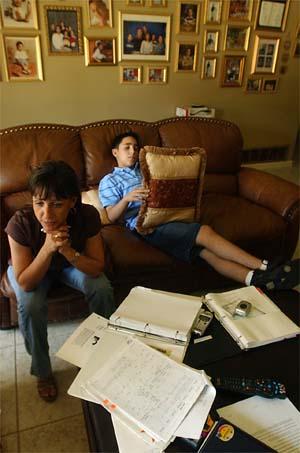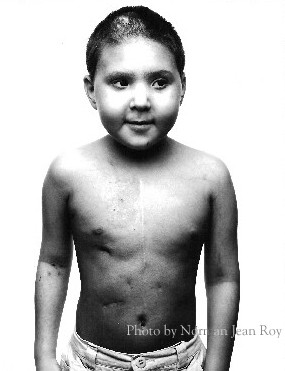
I wonder why Fanconi patients are often really good athletes. I told you about the boy who was in the Punt, Pass and Kick competition at RFK. I know that the Frohnmayers kids are all great athletes. And there was you.

Bradenton brothers with rare blood disorder await 'miracle'
DONNA WRIGHT
Herald Staff Writer
BRADENTON - To look at Anthony Negrin, one would never suspect the 16-year-old Bradenton boy with the muscle tone and grace of a born athlete is fighting for his life.

Roxanne Negrin and her son, Anthony, 16, are surrounded by information about Anthony's illness on the table in front of them, and family photos on the wall behind them. Anthony has a rare disease which requires a bone marrow transplant.
But his bone marrow can no longer make red blood cells.
Negrin has Fanconi anemia - a blood disorder so rare that only 10 to 20 children each year in the United States are diagnosed with the genetic mutation.
Until recently, Negrin had no problems, but then, for reasons his doctors cannot explain, his bone marrow stopped producing the cells vital to distributing oxygen throughout his body.
If it weren't for regular transfusions, Negrin's red blood count would drop so dangerously low that his life would be threatened.
Now, Negrin's future hangs on finding a bone marrow donor. An international search is under way to find the perfect match.
That match, says Negrin's mother, Roxanne, must have at least seven and preferably eight of the same 10 genes as Anthony has in his blood.
The Negrins thought their prayers were answered when preliminary tests showed that Anthony's younger brother, Jonathan, was a perfect 10 to 10 match - an almost unheard-of possibility.
But their hopes were dashed when subsequent tests to prepare for the transplant procedure revealed that Jonathan also has Fanconi anemia, or FA.
So far, Jonathan's bone marrow is producing red blood cells, his mother said. But doctors have told the family that Jonathan's red blood cells could dramatically drop - and they can't predict why or when.
Then Jonathan, too, would need a bone marrow transplant.
Inherited disorder
Life for the Negrins has been turned upside down since learning two of their four sons have FA.
But their optimism has not wavered, sustained by a deep faith and the support of their friends and the boys' teachers at Bradenton Christian School, who help the family navigate the mind-numbing complexities of dealing with their sons' serious medical conditions.
The Negrins' story really begins years ago when Roxanne walked into a tiny Cuban restaurant in Miami with her mother. Roxanne took one look at the handsome man in the tiny kitchen window and grabbed her mother's arm.
"That's the man I am going to marry," Roxanne said. "He doesn't know it yet, but we are going to get married."
Six months later, Sergio and Roxanne Negrin tied the knot. It would have been sooner, Roxanne said, but they had to wait on an open date for a church wedding.
Little did the happy couple know that their union would join more than love.
FA is an inherited disorder. For it to be passed from one generation to the next, both parents must carry a mutated FA gene. Even when that rare genetic combination occurs, the couple's children have just a 1-in-4 chance of developing the disease.
"What are the odds," Roxanne asked, "that I would pick a guy who had the same defective gene as me?"
Refusing to be pessimistic about their fate, Sergio jokes that what united them was the Fanconi Anemia Attraction.
United in their struggle, the sobering diagnosis has strengthened the family even more.
The Negrins feel blessed to have discovered the problem in time to do something about it.
Unlike most children afflicted with FA, brothers Anthony and Jonathan have been very healthy their entire lives and are still free of symptoms. Avid athletes, they master every sport they try, their mother said.
Typically, FA shows up in early childhood. Many patients develop acute myelogenous leukemia, according to the Fanconi Anemia Research Fund.
Anthony is not troubled by his FA diagnosis. Instead, he sees it as a sign, almost a mission.
"I feel I have been blessed," he said. "I think I have this disorder so I can bring people to Christ. I have already brought others to Christ because there are people praying for me who have never been to church before."
"We are waiting for a miracle," his mother said. "We know a miracle will come."
The signs may have already occurred, beginning with the events that led up to Anthony's diagnosis.
Fate intervenes
Last month, Anthony tried out for the tennis team at BCS. While signing up, Dawn Cotrone, the mother of one of Anthony's friends, pulled him aside. Cotrone had been taking care of her sister who had been diagnosed with a rare form of anemia. She knew how to spot the subtle signs.
Even though Anthony looked perfectly healthy, Cotrone noticed a certain cast to his skin that she thought should be checked out by a doctor.
"I blew off her concern," said Roxanne, who shares the same olive skin tone as her son.
But then one day Anthony and his friends stopped by South Philly Cheese Steak restaurant on 34th Street West. Anthony had no more than walked through the door, when a stranger walked up to him.
"Excuse me," the woman said. "But you need to tell your mother to take you to the doctor. You are anemic."
At first, the family laughed about the coincidence. But today the Negrins would love to find that woman to thank her for spurring them to action.
The Negrins called pediatrician Dr. Frank Davis, who had taken care of their boys for years.
The warnings from Cotrone and the stranger proved correct when blood test results showed that Anthony's red blood count had dropped to 4.1, his mother said. A normal reading should be around 14.
"Dr. Davis could not believe it at first," Roxanne said. He couldn't believe Anthony's count could be so low without the telltale signs - throwing up, fainting, nausea and dizziness.
But although Anthony seemed fine, his doctor knew he wasn't. He ordered the Negrins to take their son immediately to All Children's Hospital in St. Petersburg.
There, all of the tests for the most likely problems - including leukemia and aplastic anemia - came back negative, Roxanne said.
As a last resort, the All Children's team considered FA, even though Anthony showed no symptoms.
But there was one final clue to be investigated - children born with defective FA genes are often born with double thumbs on one or both hands.
At birth, Anthony's right hand had a double thumb, a tiny protuberance that was removed while he was an infant.
Absent other symptoms, the doctor who delivered him never suspected the double thumb could indicate a serious medical condition, Roxanne said.
The news that Anthony had FA stunned the Negrins. Friends from BCS - Evelyn Magley, Lisa Judge and Judy Barber - flew into action, culling the Internet for information on FA and finding resources to help the family deal with the challenges ahead.
Magley called an FA hotline and got the names of the three specialists in the United States who know how to treat the disease.
The Negrins left messages with all three, even though it was Memorial Day weekend.
Dr. Richard E. Harris of Cincinnati Children's Hospital returned the call immediately, even though he was on a scouting trip with his son.
Within 24 hours, the Negrins had an information packet sent by overnight courier to Bradenton and an appointment with Harris, who began blood tests to see if one of the family members could be a donor match for Anthony.
When the match with Jonathan was found, Roxanne, Sergio, Anthony and Jonathan flew to Cincinnati for more than four days of preliminary tests and procedures.
Now that his brother Jonathan has also been diagnosed with the disorder, those preparations must be done again once a new donor is found.
Then a another trip north will be necessary for the bone marrow transplant, which will require the Negrins to stay in Cincinnati for three months during the recovery period.
The challenges don't end with a successful bone marrow transplant.
Anthony faces several months of recovery once he returns home. His parents face the challenge of making their house as antiseptically clean as possible to ward off any exposure that could prove disastrous for Anthony, whose immune system will be compromised.
But through it all, Roxanne has not given up hope. Her husband, Sergio, she said, is the family's anchor. Her son, Anthony, the optimist who helps her cope.
"My Anthony charges me up like a little wind-up doll," she said. "Whenever I get down, he tells me, 'Come on Mom, God already knows who that donor is.'"
Donna Wright, health and social services reporter, can be reached at 745-7049 or at dwright@HeraldToday.com.
Bone marrow donation
To register to become a donor, contact the National Bone Marrow Donation Program at (800) 627-7692.
What is Fanconi anemia?
Fanconi anemia is one of the inherited anemias that leads to bone marrow failure (aplastic anemia). It is a recessive disorder, meaning if both parents carry a defect (mutation) in the same FA gene, each of their children has a 25 percent chance of inheriting the defective gene. When this happens, the child will have FA.
Extremely rare, FA is diagnosed in only 10 to 20 children in the United States each year.
FA occurs equally in males and females. It is found in all ethnic groups. Though considered primarily a blood disease, it can affect all systems of the body. Many patients eventually develop acute myelogenous leukemia at a very early age. FA patients are extremely likely to develop head and neck, gynecological and/or gastrointestinal squamous cell carcinomas, again at a much earlier age than in squamous cell carcinoma patients in the general population.
Patients who have had a successful bone marrow transplant and, thus, are cured of the blood problem associated with FA, still must have regular examinations to watch for signs of cancer.
--------------------------------------------------------------------------------
© 2006 Bradenton Herald and wire service sources. All Rights Reserved.
http://www.centredaily.com


No comments:
Post a Comment